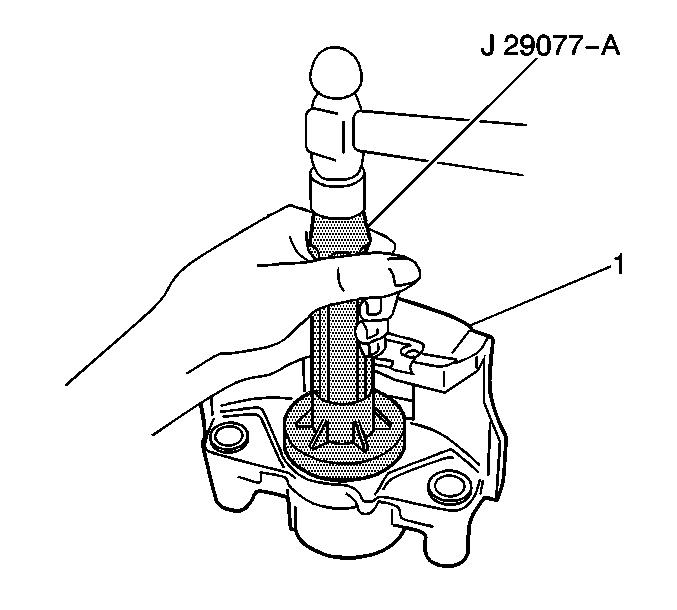Removal Procedure
Tools Required
J 35777 Caliper Piston Seal Installer.
- Raise and support the vehicle. Refer to Lifting and Jacking the Vehicle in General Information.
- Remove tire and wheel assembly. Refer to Tire and Wheel Removal and Installation in Tire and Wheel.
- Remove the caliper (1) from the vehicle.
- Remove the bushings (6).
- Inspect the bushings for nicks and cuts. Replace the bushings if damaged.
- Use clean shop towels to pad the interior of the caliper during piston removal.
- Remove the piston using compressed air into the caliper inlet hole.
- Inspect the piston for scoring, nicks, corrosion, and worn or damaged chrome plating. Replace the piston if any of these are found.
- Remove the boot. Be careful not to scratch the housing bore.
- Remove the piston seal from the seal groove in the caliper bore using a small plastic or wood tool. Do not use a metal tool because this may damage the caliper bore or seal groove.
- Inspect the caliber bore and seal groove for scoring, nicks, corrosion and wear.
- Use a crocus cloth to polish out light corrosion. Replace the caliper housing if corrosion in and around the seal groove will not clean off with a crocus cloth.
- Remove the bleeder valve cap.
- Remove the bleeder valve from the caliper.
- Clean all parts in clean, denatured alcohol.
- Dry the parts with unlubricated compressed air.
- Blow out all passages in the caliper housing and bleeder valve.

Caution: Do not place fingers in front of the caliper piston(s) in an attempt to catch or protect it when applying compressed air. The piston(s) can fly out with force and could result in serious bodily injury.

Installation Procedure
- Install the bleeder valve.
- Install the bleeder valve cap.
- Install the lubricated new piston seal into the caliper bore groove. Make sure the seal is not twisted.
- Install the lubricated boot into the bore of the caliper. Push the piston to the bottom of the bore.
- Using the J 35777 , seat the boot in the caliper housing.
- Install the bushings.
- Install the caliper into the vehicle.
- Install tire and wheel assembly.
- Lower the vehicle.
Notice: Use the correct fastener in the correct location. Replacement fasteners must be the correct part number for that application. Fasteners requiring replacement or fasteners requiring the use of thread locking compound or sealant are identified in the service procedure. Do not use paints, lubricants, or corrosion inhibitors on fasteners or fastener joint surfaces unless specified. These coatings affect fastener torque and joint clamping force and may damage the fastener. Use the correct tightening sequence and specifications when installing fasteners in order to avoid damage to parts and systems.
Tighten
Bleeder valve cap to 13 N·m (110 lb in)

| 6.1. | Lubricate the beveled end of the bushing with silicone grease. |
| 6.2. | Pinch the bushing and install the beveled end first. |
| 6.3. | Push the bushing through the housing mounting bore. |
